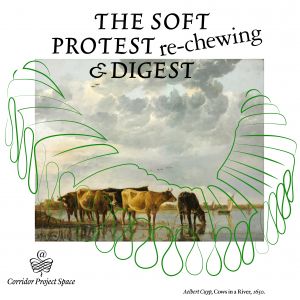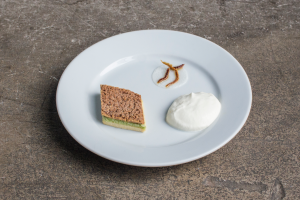Answering to the invitation of Corridor project space to take part in its “Side dish” program, The Soft Protest, Digest put together a 3 course dinner followed by a week exhibition titled: “The Soft Protest, re-chewing & Digest”.
Starting on the night of October 4th on the banks of Amsterdam's IJ river, the event was centered around the collaboration between the cow and the grass, working as agents for recycling and storing carbondioxide in the ecosystem of the soil.
Extract of the press release:
“The re-distribution of CO2 from the atmosphere into the soil, mediated by the cow and the grass as part of the carbon cycle, could play a part in reversing climatic issues, while also answering to two controversial and often appraised subjects, the cow and CO2. Today, the cow is mainly valued for its milk, but what if it would be valued for the work it was doing while grazing? What if the cow was seen as a beneficial actor of the ecosystem? The grazing cow could help consume biomass, fostering regrowth and carbon storage, prevent wild fires, regulate hydrology, conserve grasslands's biodiversity and pollinators, spreading of seeds, organic matter and nutrients, etc. The research collective would like to speculate and partake in the future of the cow, the essential actor of the dutch's food culture.”
The dinner
The dinner, which gathered 40 guests, was set around short talks on topics such as:
- The history of the dutch dairy industry and the impact of its lobbies
- How does CO2 contribute to a healthy ecosystem and how to store it back into the soil?
- From grass to cheese, a journey into the cow's digestive system
- On CO2 grazing cows, an interview with farmer Corneel van Rijn, dutch organic dairy farmer, involved in the “Agricultural European Innovation Partnership”
- The conservation of milk in India
- 3 scenarios: the possible futures of the cow
The dishes
Each of these speeches was illustrated by the serving of dishes[1]:
- Introductive bite
- Grutto, weidevogel
- Rumen, digestive system
- Herbal tea and caramelized nuts
- Het Groene Hart
- Rivella[2]
The exhibition
Following the dinner, an exhibition on the subject was held for a week and included:
- An hour long podcast titled “What about CO2 grazing cows?”.[3]
- The ceramic work of Denise Aimee Rijnen (Darc matter ceramics).
Denise produced two custom stands for a veal tongue and its digestive system. - Table linen produced by Lotte van de Hoef.
These textiles, made out of cheese-cloth were dyed in the food scraps of the dinner. - 4 pedagological drawings, handpainted on cheese cloth.
These drawings illustrated: the cow's digestive system, the life cycle of a plant, the carbon cycle revolving around the cow, the logic behind the growth of grass
Podcast
🔊What about CO2 grazing cows? — Podcast (~1 hour)
Gallery
- Rechew table.png
- Rechew main.png
- Rechew starter.png
- Rechew poster.png
- Rechew nickie.png
- Rechew podcast.png
Specials thanks
- Nolwenn Salaün
- Suzan Kalle
- Suat Ogut
- Corneel van Rijn
- Lorene Wart
Notes
- ↑ The food was produced in collaboration with chef's duo Axe&Porridge who delivered the amuse and palate cleanser, as well as helped conceive the main dish.
- ↑ A conventional soda drank in the Netherlands containing +26% of cow whey
- ↑ Including our interview of Corneel van Rijn, dutch organic dairy farmer, involved in the “Agricultural European Innovation Partnership







